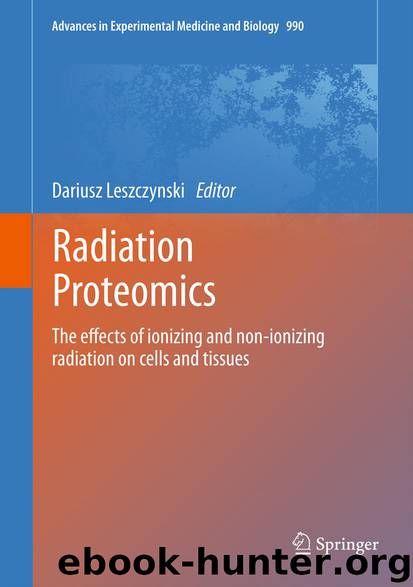Radiation Proteomics by Dariusz Leszczynski

Author:Dariusz Leszczynski
Language: eng
Format: epub
Publisher: Springer Netherlands, Dordrecht
4.2 Normal Tissue Radiation Toxicity
All tissues are damaged by ionizing radiation [10]. The damage in normal tissues results from the initial deposition of energy within the tissue. The pathological processes of the radiation injury begin at once after the irradiation, but the clinical and histological signs cannot become visible before weeks, months, or even years after an accidental exposure or after a therapeutic treatment [2, 10].
The acute effects are mainly observed in tissues with fast renewal, for example epithelia of the skin surface or the digestive tract. The symptoms develop when functional cells are lost, because of the turnover of the normal tissue, and are not replaced because of the damage sustained by the stem cell compartment. In tissues as the skin or the bowel, there are compensatory phenomena involving the proliferation of stem cells, which are more tolerant to ionizing radiation than the other cells and replace the cells of the tissue thereby allowing its repair. The symptoms remain during this phase, which may continue throughout radiotherapy treatment. Cells die generally during mitosis, in the course of one or more of the first divisions which follow irradiation, because of damaged chromosomes which are not or badly repaired (mitotic death). Other cellular types, for example lymphocytes, can die by apoptosis, a fast death in particular tissue locations. Cells can also leave the reproductive pool by differentiation [11]. This cellular senescence is a particularly important response of fibroblasts, which can lead to excess deposition of collagen and subsequently to fibrosis. Early effects, such as erythema of the skin, probably involve mechanisms other than cellular death. Irradiation activates various cell signaling pathways [12], leading to the expression and activation of proinflammatory and profibrotic cytokines [3, 13–15], vascular damage [16, 17], and activation of coagulation [18]. These changes can then lead to edema, inflammatory responses, and initiation of a healing-like process: waves of cytokines are produced in an effort to cure the damage [3, 19].
Late effects develop months to years after an exposure and are mainly observed in patients undergoing radiotherapy. The symptoms can be moderate to severe, limited or progressive, and can develop gradually or suddenly. The late effects tend to develop in tissues containing cells which are slowly renewed (subcutaneous tissue, fatty tissue, muscle, brain, kidney, liver), or sites of low renewal inside tissues which contain cells which quickly proliferate (wall of the intestine). Usual tissue lesions are fibrosis, necrosis, atrophy, and vascular damage. Late effects develop through complex processes which interact together [20] and which are not currently fully understood, in particular regarding the role of cell death. Cells are part of a community in which the members depend on each other and contribute individually to the functioning of the tissue and the whole body. The production and release of cytokines and growth factors are an integral part of the response to irradiation and lead to an adaptive response and to the infiltration of cells related to the mechanism of healing. This process is perpetuated by cell death and consequent
Download
This site does not store any files on its server. We only index and link to content provided by other sites. Please contact the content providers to delete copyright contents if any and email us, we'll remove relevant links or contents immediately.
| Automotive | Engineering |
| Transportation |
Whiskies Galore by Ian Buxton(41879)
Introduction to Aircraft Design (Cambridge Aerospace Series) by John P. Fielding(33064)
Small Unmanned Fixed-wing Aircraft Design by Andrew J. Keane Andras Sobester James P. Scanlan & András Sóbester & James P. Scanlan(32743)
Craft Beer for the Homebrewer by Michael Agnew(18140)
Turbulence by E. J. Noyes(7936)
The Complete Stick Figure Physics Tutorials by Allen Sarah(7307)
Kaplan MCAT General Chemistry Review by Kaplan(6867)
The Thirst by Nesbo Jo(6828)
Bad Blood by John Carreyrou(6552)
Modelling of Convective Heat and Mass Transfer in Rotating Flows by Igor V. Shevchuk(6391)
Learning SQL by Alan Beaulieu(6211)
Weapons of Math Destruction by Cathy O'Neil(6146)
Man-made Catastrophes and Risk Information Concealment by Dmitry Chernov & Didier Sornette(5921)
Digital Minimalism by Cal Newport;(5664)
Life 3.0: Being Human in the Age of Artificial Intelligence by Tegmark Max(5474)
iGen by Jean M. Twenge(5366)
Secrets of Antigravity Propulsion: Tesla, UFOs, and Classified Aerospace Technology by Ph.D. Paul A. Laviolette(5309)
Design of Trajectory Optimization Approach for Space Maneuver Vehicle Skip Entry Problems by Runqi Chai & Al Savvaris & Antonios Tsourdos & Senchun Chai(5011)
Pale Blue Dot by Carl Sagan(4912)
